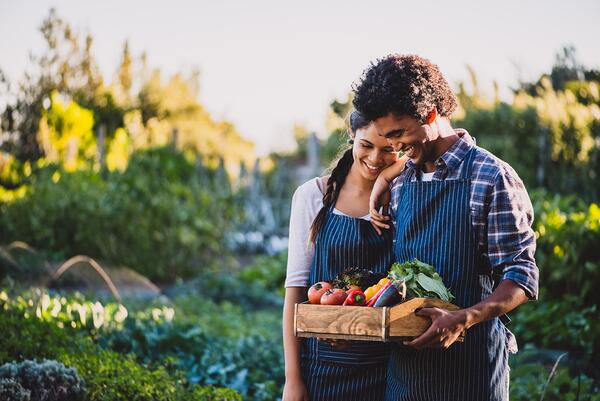
URBANA, Ill. – While Ireland is known for potatoes and Italy for its tomato-based sauces, many iconic fruits and vegetables have a tangled global history that has led to what ends up in your garden or on your plate. If someone says aubergine and you say eggplant, or maybe chickpeas and garbanzo beans, it turns out you are both right.
Seed catalogs, farmers markets, and grocery stores are filled with a wide variety of fruit and vegetables that go by different names depending on where you live. The word fruit itself can be traced back to the Latin word “fructus,” derived from “frui” which means to enjoy or delight. The word vegetable comes from the proto-Indo-European root word “weg,” which means strength or liveliness.
Below is a list exploring the cultural and linguistic history of common fruits and vegetables. Some were named after their appearance, where they are from, or because they resembled something else. Many predate written history and the time periods are estimates of when the food was cultivated.
Apple
1,000,000 years ago: Central Asia
Old English: æppel, derived from Proto-Germanic ap(a)laz; Old Norse: eple; Old High German: apful; and Old Irish: ubull. Scientific name: Malus domestica.
Alexander the Great supposedly introduced the apple to Europe in 300 BCE. The first European settlers of North America brought apples with them and developed their own varieties, mostly for cider.
Avocado
8,000 BCE: Puebla, South Central Mexico
Nahuatl Aztec language: āhuacatl; Spanish: aguacate; English: avogato, which became avocado; French: avocat; Scientific name: Persea americana.
The Aztecs believed that eating avocado provided strength. It is believed that Mesoamerican tribes first domesticated the avocado tree 5,000 years ago.
Banana
500 CE: Papua New Guinea and Southeast Asia
Arabic: banan “finger”; Senegal and Gambia (Wolof people): banaana; English: banana; Scientific name: Musaceae sapientum.
It has been thought that bananas arrived in Madagascar with the Malagasy people from Borneo around 500 CE. Around 1500 CE, Portuguese sailors took the banana to plantations in the Atlantic Islands, Brazil, and Western Africa.
Cilantro, coriander
6000 BCE: Mediterranean regions
Spanish: cilantro; British English: coriander; Latin: coriandrum; Greek: koris; Scientific name: Coriandrum sativum.
For millennia, cilantro and coriander have been considered an herbal holistic medical wonder, used to treat indigestion, flatulence, and insomnia. In the U.S., the stalk and leaves are known as cilantro, while the seeds are referred to as coriander. In the U.K., coriander is the seeds, stalks, and leaves.
Eggplant, aubergine
50 BCE: India or China
Arabic: al-bāḏinjān, from the Sanskrit vatimgana; American English: guinea squash and later eggplant; British English and French: aubergine; Scientific name: Solanum melongena.
Eggplant, or aubergine, belongs to the nightshade family of vegetables (Solanaceae) and comes in a variety of colors: deep purple, lavender, jade green, orange, and yellow-white.
Garbanzo bean, chickpea
6790 BCE: France
American English: garbanzo bean from Spanish: garau meaning “seed” and antzu meaning “dry;” British English: chickpea from Latin: cicer and French: chiche; Scientific name: Cicer arietinum.
Chickpeas currently supply more than 20% of the world with protein, but crops are under threat from climate change coupled with a lack of genetic diversity. India produces the most chickpeas in the world, but they are grown in more than 50 countries.
Pineapple
13th century CE: Brazil’s Parana Paraguay River basin
English: pineapple; Spanish: piña; many parts of the world: ananas; Scientific name: Ananas comosus.
When Europe began importing pineapples, most nations referred to the pineapple by its native Tupi name in Brazil “ananas.” The English named the fruit “pineapple” because it looks similar to a pinecone. In those days “apple” described any roundish, foreign fruit.
Potato
3rd century CE: Peruvian-Bolivian Andes
Spanish: batata or papa from the Andean Quechua language; English: potato; French: pomme de terre or “earth-apple;” German: erdapfel; also, kartoffel from the Italian tartufolo, meaning ‘truffle,’ and grundbirne, meaning “basic pear;” Scientific name: Solanum tuberosum.
Cultivated by the Incas, the word “potato” comes from the Taíno batata. Sir Walter Raleigh introduced the white potato to the British Isles and, instead of using papa from the Andean Quechua language, as the Spanish had, the English named it “Virginia potato” after the New World colony.
Sweet potato vs yam
Sweet Potato: 2500-1850 BCE in Peru / Taíno language: batata (origin of the word “potato;” Scientific name: Ipomoea batatas
Yam: 8000 BCE in Africa and Asia / Wolof language: nyami “to eat;” Portuguese: inhame; Spanish: ñame; Scientific name: Dioscorea alata
Sweet potatoes and yams are not related botanically. Sweet potatoes are members of the morning glory family, while yams are related to lilies and grasses. Unless you are looking for yams in an international market in the U.S., you are probably eating sweet potatoes.
Zucchini, courgette
5000 BCE: Mesoamerican region, Central America and Mexico
North American and Australian English: zucchini from Italian: zucca; British and New Zealander English: courgette from French for “gourd;” South Africa: “baby marrow;” Scientific name: Cucurbita pepo.
Courgettes are young, finger-size vegetables, between 1½ to 5½ inches in length, while zucchinis are larger. Zucchinis appeared in North America in the 1920s, probably brought back by Italian immigrants.
If your interest in fruits and vegetables has been piqued, explore more about growing produce by connecting with your local Illinois Extension county office at go.illinois.edu/ExtensionOffice.
Monique E. Rivera is an Illinois Extension Translation Specialist. Gardeners Corner is a quarterly newsletter from gardening experts around the state. Each issue highlights best practices that will make your houseplants, landscape, or garden shine in any season. Join the Gardener’s Corner email list at go.illinois.edu/GCsubscribe for direct access to timely tips.
ABOUT EXTENSION: Illinois Extension leads public outreach for University of Illinois by translating research into action plans that allow Illinois families, businesses, and community leaders to solve problems, make informed decisions, and adapt to changes and opportunities.